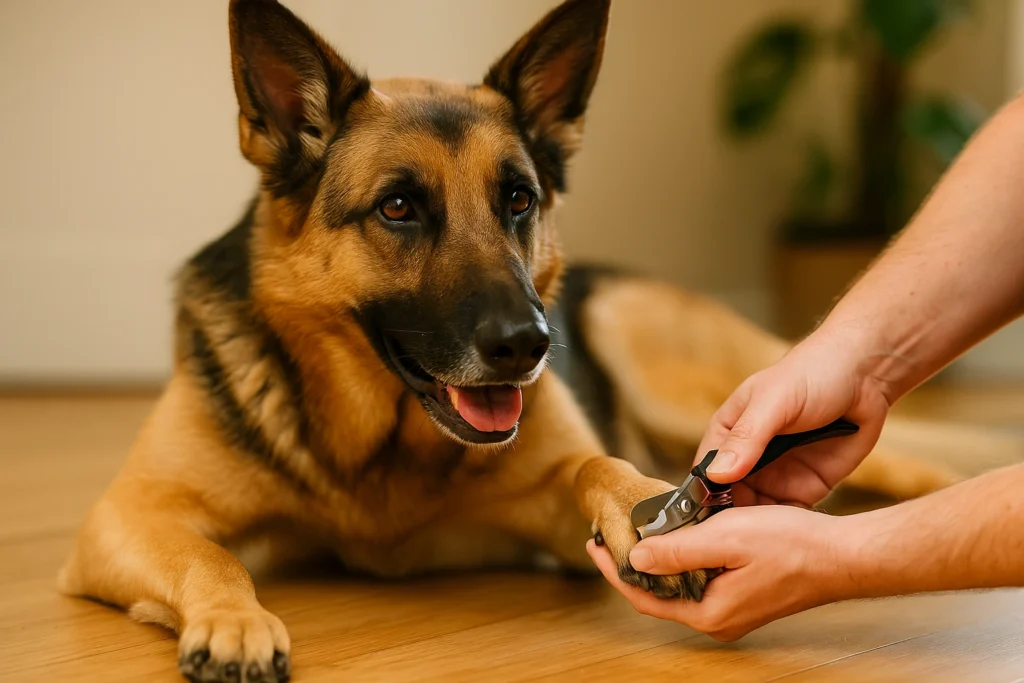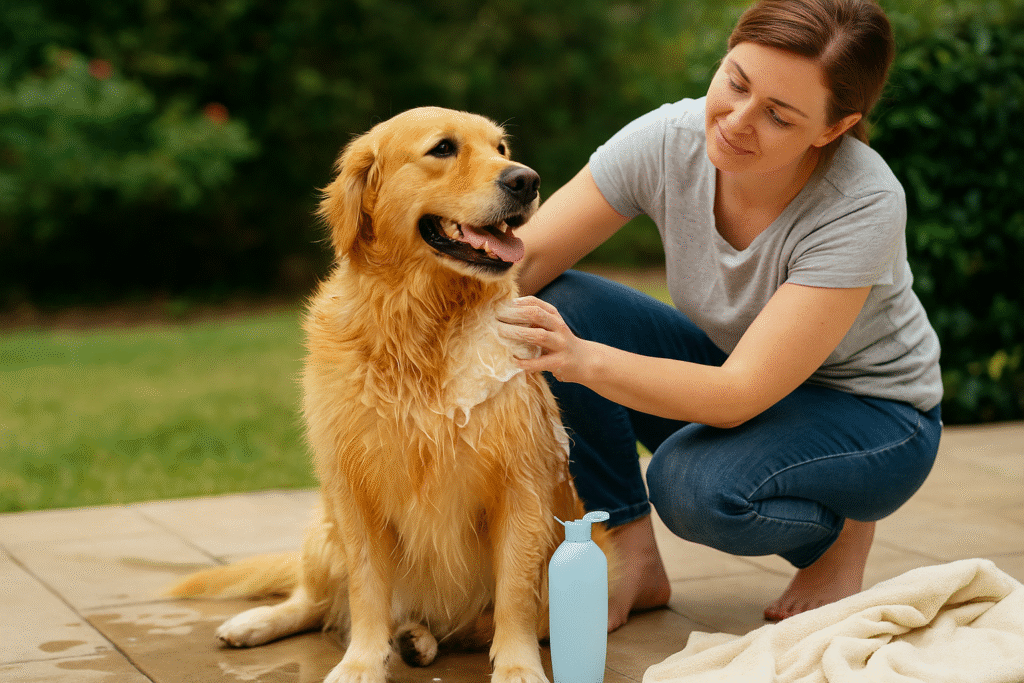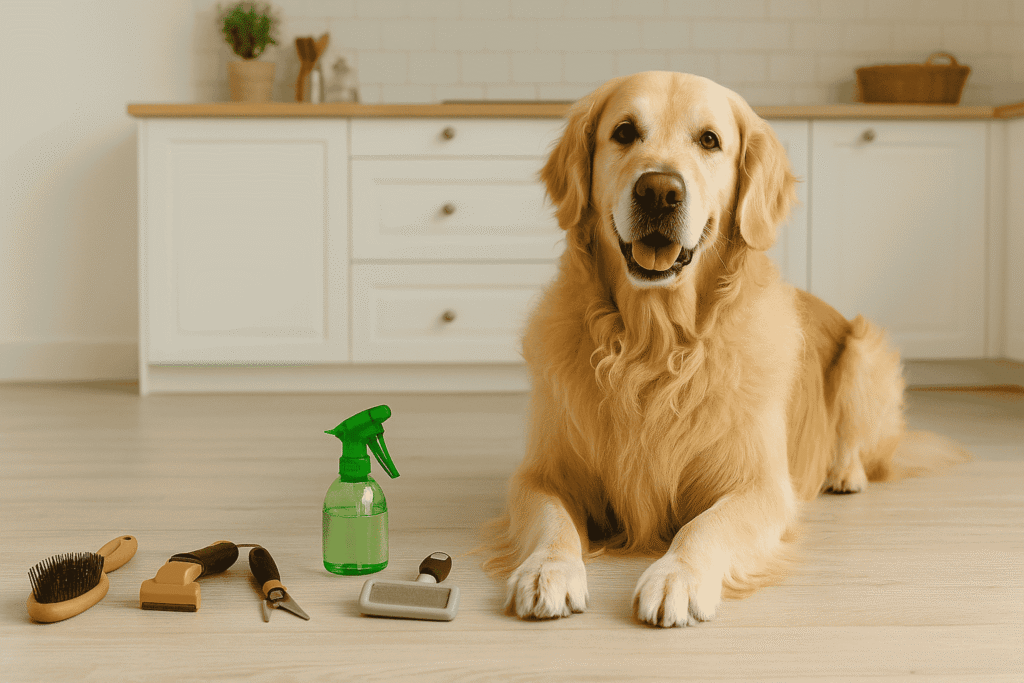Let me guess: you’re standing in your living room with dog nail clippers in hand, staring at your pup’s paws, heart pounding a little because trimming nails feels—let’s admit it—like performing tiny surgery. And you wonder, is this really safe?
I’ve been there. When I first tried trimming my dog Bella’s nails, she yelped, I panicked, and I accidentally nicked her quick. Cue tears, whining, and me fumbling for styptic powder. We both were tense for days—neither of us distracted by my makeshift band-aid.
Fast-forward: today, Bella hops onto her “trim mat” whenever she hears the grinder buzz. I have calming music playing in the background, clippers and files are prepped, and a treat pouch is on standby. She sits like a champ. We still celebrate afterward.
What changed? I learned how to trim a dog’s nails without hurting them—no stress, no struggle, just confidence and care.
This guide will walk you through:
- The right dog nail trimming tools for safety and ease
- How to identify the quick and avoid cutting it
- A step-by-step safe dog nail trim process
- Ways to calm anxious pups
- What to do if you accidentally go too short
- When to seek help from a professional
By the end, you’ll have the tools, technique, and emotional calm needed for successful trims—and a free Dog Nail Trimming Checklist to keep by your side.
Ready to turn nail-time from anxiety to ease? Here’s how to trim your dog’s nails the right way.
1. Why Safe Dog Nail Trimming Matters
Understanding Your Dog’s Nail Anatomy
A dog’s nail has two parts:
- A tough outer nail
- An inner tender part called the quick, which contains nerves and blood vessels
Trim too close, and you’ll hit the quick—resulting in pain and bleeding. That’s why knowing how to trim dog nails without hurting them is crucial.
The Risks of Neglect
Leaving nails long can cause serious issues:
- They can curl and grow into foot pads—painful and prone to infection
- Long nails alter paw alignment, increasing joint injury risk
- Nails may snag and tear if left untrimmed
Regular, safe trimming keeps your dog comfortable, healthy, and hazard-free.
2. Tools & Setup for a Stress-Free Nail Trim
Choosing the Right Dog Nail Trimmer
- Plier-style trimmers: strong and ideal for medium to large breeds.
Product Suggestion: Boshel Dog Nail Clippers
Why: Easy to use, safety guard, ergonomic handle—perfect for beginners. - Guillotine trimmers: easy for beginners and small/medium nails
- Scissor-style trimmers: best for small nails, with curved blades
- Nail grinders: smooth finish but need dog acclimation
Prep Supplies You’ll Need
- Styptic powder for emergencies
- A metal file or rotary tool for finishing
- Cotton pads or paper towels
- Calming treats and rewards
- Good lighting or natural daylight
Creating the Right Environment
- Choose a comfortable, well-lit space
- Consider calming music or a pheromone diffuser
- Prepare treats before starting — no scrambling mid-session
3. Step-by-Step: How to Trim Dog Nails Safely
Acclimate Your Dog
- Touch paws, muzzle fear bit by bit
- Offer treats as you approach the paws and clippers
Inspect Each Nail
- Identify the quick—visible on light nails, hidden in dark nails
- Aim to trim 2–3 mm away from the quick for safety
Make the Cut
- Hold the paw firmly but gently
- Position the trimmers with the blade flush to the nail end
- Trim in a swift, clean motion—never saw at the nail
Finish with a Smooth Edge
- Use a file or grinder to remove sharp edges
- Product Suggestion: Dremel 7300-PT Dog Nail Grinder
Why: Trusted brand, quiet motor, cordless.
Handle Accidental Cuts
- Apply styptic powder immediately
- Offer calm reassurance and a treat
- Pause or postpone remaining nails if needed
4. Reducing Stress & Anxiety During Nail Cutting
Build Confidence Gradually
- Practice paw handling regularly without trimming
- Introduce trimmer noise slowly—treats for calm behavior
Use Positive Reinforcement
- Praise, clickers, and treats reinforce calm cooperation
Case Example: Max vs. Thunderstorm Anxiety
Max panicked with the clippers at first—but regular exposure plus chews and soft brassica music made him calm enough to sit. It took two weeks, but we now breeze through trims together.
5. Dog Nail Trimming Checklist
Prep Tools & Setup
- Choose a quiet, calm space
- Gather nail trimmer or grinder
- File or rotary tool for smoothing
- Styptic powder (or cornstarch) on hand
- Tissues, towel, or cotton pads
- High-reward treats
- Calming music or pheromone spray (optional)
Before You Trim
- Let dog sniff and see the tools
- Touch and hold paws calmly
- Practice with mock trimming sessions
- Ensure your lighting is bright enough
- Wash or wipe paws if dirty
During the Trim
- Hold paw gently but firmly
- Locate the quick (visible on light nails)
- For black nails, trim tiny bits at a time
- Trim 2–3 mm away from the quick
- Smooth edges with file or grinder
- Watch for signs of stress or resistance
- Offer a treat after each successful cut
If Bleeding Happens
- Stay calm—this is common
- Wipe blood with clean tissue
- Apply styptic powder and light pressure.
Product Suggestion: Kwik Stop Styptic Powder
Why: Must-have for nail bleeding; trusted in vet clinics. - Give your dog a break and praise
Aftercare & Routine
- Trim nails every 2–4 weeks
- Log the date in your grooming journal
- Watch for cracks or limping
- Reinforce good behavior with praise/treats
6. Reducing Stress & Anxiety During Nail Trims
Build Trust Slowly
Start with handling: gently hold paws while watching TV or during cuddle time. Let your dog get used to the sensation before introducing trimming tools. Reward calm behavior with treats or praise so they associate touch with positivity.
Real-life tip: My rescue pup Luna was terrified at first. I spent a week simply holding her paws for a second, then three, rewarding her every time. By the third night, she was happily leaning into my hand—no trimming needed yet. It made the actual trim a breeze.
Introduce Noises Gradually
Grinders and nail clippers can sound intimidating.
If you’re using a dog nail grinder, let your dog hear it turned off, then just buzzing, days before actually touching nails. Offer treats each step until buzzing near their paws is no big deal.
Create a Calm Environment
Choose a quiet, comfortable location with soft lighting.
Play soothing music or use a pheromone diffuser to help anxious dogs settle. Have treats ready and speak in gentle, encouraging tones. A relaxed atmosphere prevents stress—for you and your dog.
7. When to Call in the Pros
Groomer or Vet Visits
If your dog fights, cries, or seems traumatized by nail trims, a professional groomer or veterinary technician can help. Many groomers offer gentle handling and know how to deal with sensitive dogs. Sedation can be an option—but more common are skilled techniques and patience.
Alternative Nail Maintenance Methods
Sometimes, trimming isn’t workable. Consider:
- Scratching posts or pads: Give dogs surfaces that naturally grind nails.
- Daily walks on hardy terrain: Pavement or gravel can help naturally wear down nails.
These methods don’t replace trimming entirely but can reduce the frequency needed. Always monitor nail length—it’s easy to miss a quick growing too long.
8. Maintenance Routine & Schedule
How Often Should You Trim?
- Active dogs: every 3–4 weeks
- Less active or indoor-only dogs: every 2–3 weeks
Developing a consistent routine prevents quick overgrowth and pain.
Keeping a Trim Log
Write down dates when you trimmed nails. Note any bleeding or anxious behavior. This helps you watch patterns and identify if the quick grows too close.
Nail Health Signs to Watch For
Look for:
- Cracked or split nails
- Signs of infection around the nail (redness, swelling)
- Limping or hesitation to walk
If you notice anything off, consult your vet promptly.
Common Trimming Mistakes & How to Troubleshoot
- Cutting too far: Causes pain and bleeding
Fix: Stick to safe distance—2–3 mm from the quick. - Jagged edges: Can snag or itch
Fix: Always finish with a file or grinder. - Freezing during trim: Rushing leads to mistakes
Fix: Pause and return when both you and your dog are calm. - Using dull tools: Increases risk of splitting nails
Fix: Replace blades promptly or sharpen regularly.
You Can Do This: Healthy Nails, Happy Dog
Trimming your dog’s nails doesn’t have to be stressful. With the right tools, gentle methods, and a positive environment, it can become a peaceful part of your routine—one both you and your dog can count on for years to come.
Final Thoughts
You’re taking an amazing step by learning the gentle art of how to trim a dog’s nails without hurting them. Your patience matters. Your calm presence matters. And your love—for your dog and their comfort—matters most of all.
Grooming isn’t just about nail trims—here’s how often you should bathe your dog based on coat and season to keep their skin and fur healthy too.
Now, clip those clippers, groom with care, and build trust—one paw at a time.




